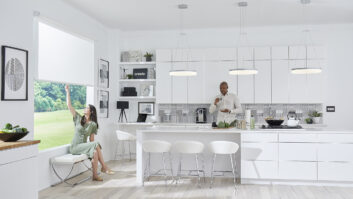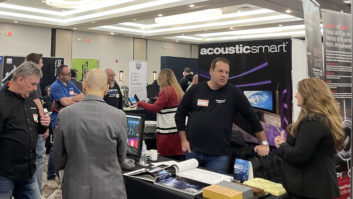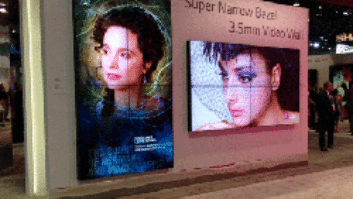OK, I admit it. I’ve long been what some of my friends in the rep world call a “show dog.” I’ve (almost) never been to a trade show or convention that I didn’t like. Of course, CEDIA is perhaps the most important event for all who read this publication, and I’ve only missed one CEDIA since the show was created. The one thing I’m always asked after any trade show is, “What was the most important thing I needed to see, but didn’t?”

Don’t worry. The entire RS team will be on hand to report both online and in print on all the latest news from CEDIA this month in San Diego, but it’s always best to see things firsthand. As this is written in early August, it is difficult to tell you too many details in advance, but the next best thing is to clue you in as to what to look for in terms of broader categories. By taking the “30,000-foot view” you’ll have a better way to start your planning, make your meeting appointments, and make the most of your CEDIA visit.
Here are the areas that we’ll be looking exploring.
HDR for All Video Device Categories
Let’s face it, other than a 32-inch TV for a secondary viewing location, or a 1080p set for areas like exercise rooms or the teenagers’ bedrooms, virtually every display you will likely provide and install will be a UHD 4K product. Even that category, however, has experienced rampant price compression. To get out of the low-priced mud, you really should turn to products with high dynamic range (HDR). Remember, it’s not just “more pixels” (3840×2160 resolution), but “better pixels” (HDR) that is the most dramatic and demonstrable benefit of UHD.
For our market, you won’t have to look far for HDR, but as the market grows, so do the options and decisions. You won’t have to ask if an “HDR TV” is HDR-10 compatible, for that is now the base format. But you should go to CEDIA to find out what companies will be offering HDR-equipped front projectors.

Stepping up the ladder from HDR-10 will be TVs with Dolby Vision, a technology that incudes dynamic metadata that allows the set to change in response to the varying frame information rather than be set once for a program. You would think that would be a natural, but the extra cost involved on the manufacturer’s side has made it a bit of a rarity. Will there be more displays with Dolby Vision? Will there be any projectors with it? I’ll be looking for that, and you should, too.
Of course, a display without content is not very useful. To date, the clear majority of HDR content has been HDR-10, but the studios are ratcheting up the availability of Dolby Vision programs. In turn, that means that if the display has it, your clients will also want it in optical players and streaming devices. Will anyone else join the Chromecast Ultra in offering Dolby Vision? That’s important. Even more so, look for any new Ultra HD Blu-ray players that come with the format, or at least promise to offer it down the road as an update. Some will, some won’t.
The same holds true for AVRs and surround sound processors. Do the brands you favor offer it or will they add it as an upgrade? With virtually all the brands in those categories present, CEDIA is the place to find out, so that you are ready to answer client questions on that score.
Finally, it will be interesting to see if anyone else jumps on the HDR-10+ train that Samsung has started. The 2017 Samsung sets all have it, albeit for streaming content only. At this point there are no other brands with HDR-10+ sets, no optical players, and no announcements of discs with it. In fact, it is still a bit unclear if the connection to external devices will require HDMI 2.1, or whether HDR-10+ will pass through the current 18Gbps limit of HDMI 2.0.
HDMI 2.1
The first public announcement of the forthcoming 48Gbps and 8K-compatible HDMI 2.1 format came in January at CES. Since then, there has been no update on its status. Will anyone announce products with HDMI 2.1, or will that have to wait until CES 2018? Given the attention given to this in the popular and enthusiast press, this is a simple thing to keep an eye peeled for, but a very important one.
LCD/LED, QLED and OLED and Displays
Here, too, the massive advertising of the TV brands will make this something you really need to be up to date on. This isn’t only a question of “who offers which one?” and “which one is better?” but it is essential that you are able to determine which is right for a specific client and installation. It is highly recommended that you not only gather information from the show floor, but also from CEDIA education courses.
While we are on the subject of displays, there has been a trend toward laser-engine, short-throw projectors. Look to see who joins that category, and if any have HDR.
Finally, there is the beginning of movement toward practical “micro LED” displays. You may have seen Sony’s Crystal LED, formerly known as “CLEDIS” at CES, ISE, or InfoComm. In addition, Samsung is close to opening the first cinema in the U.S., to join one in Korea, with their Samsung Cinema Screen System using the same micro-LED technology. It’s doubtful that either of these will be at CEDIA, but you never know. More importantly, keep an eye out for any news about these large, bright, high-resolution systems. Their pricing is still very much in the stratospheric range. Then again, isn’t that the business many of you are in? When I asked a Samsung executive about this at a conference back in July he admitted that they already have inquiries and perhaps even orders for this for very high-end residential installations.
While not quite as large and high resolution, it is expected that there will be some large LED-direct products at CEDIA. Do any of your clients have large outdoor spaces where video is desired? These are something to look for.
Immersive, Object-Based, Streaming Multi-room, and Other Audio Products
Over the past few years, Dolby Atmos, DTS:X, and Auro-3D have become mainstays. At this year’s CEDIA, look for AVRs and processors with higher channel counts so that home theater systems will be even better able to rival commercial cinemas. Also, look for more options for speakers designed for optimized presentation of the immersive systems, including soundbars.
While traditional, wired, multiroom audio distribution has lost ground to wireless systems, the category as a whole is growing quickly. Here, the obvious things to peruse are the leading ecosystems such as Sonos, Play-Fi, HEOS, Bluesound, and Blackfire’s FireConnect, and brand-specific systems such as Yamaha’s MusicCast. However, with the incredible success of Amazon’s Alexa products, Google’s Chromecast, and Google Home, one of the most important things to look for on the audio side is to see how products powered by either of the two giants’ products will compete with the incumbents. In particular, see if Amazon will expand the multiroom capabilities of the Alexa range.
VUI-Controlled Devices and Skills
While everyone seems to be thinking of audio in terms of either “connected products” or multichannel, home theater-centric products, and high-resolution audio, the real excitement these days is in the category of standalone devices with “VUI,” or voice user interface. Call it what you will, the consumer acceptance of Alexa and Google Home have made this the category of the year in the industry. According to voicebot.ai, Amazon’s Alexa now has more than 15,000 skills, Google Home is said to have fewer than 600, and Microsoft Cortana fewer than 75 as of August.
While the latter two counts are currently lagging behind the leader, this is where both the action and the excitement is going to be. The original “tall” Echo is due for a replacement, but what will it be and when? Google Home will likely stay as it is, but it they introduce a competitor for Dot? Microsoft’s Cortana will probably first see the light of day in the Harman Kardon Invoke. A visit to the Harman booth to see if it will be there is definitely in order. Similarly, though Samsung’s Bixby is currently a phone-based assistant only, with Harman now part of Samsung, will we also see a home-centric product with Bixby, as well?
Back to VUI, the next thing to watch for is what will be able to listen and act when the client says “Alexa…” or “OK Google.” Will it be audio products such as third-party streaming speakers? Independent versions of Amazon Show? TV sets or updated dongles including an updated Fire TV? What will be the place of products such as Josh.ai in this mix? All of those will further expand the market for VUI “listeners” even further.
The next part of this is devices that will react through skills. Yes, it isn’t that difficult to build one, and in fact, that is something worth knowing how to do. After all, many of you have been programming control and keypad products for years, so how much more difficult can this be? On the other hand, scouring the show floor for new devices that have skills will certainly simplify your work and make integration more efficient and reliable.
Everything Else
Networking and remote network management is a key area where you will need to find out how to stay ahead with strong, secure, high-bandwidth networking in the face of the growing universe of mesh-based DIY home networking products. Don’t forget the benefit of products that enable you to benefit from recurring monthly revenue, or RMR. Wouldn’t it be nice to have products that you can profit from on a continual and consistent basis, not just once?
HDMI over IP is a category that has grown significantly since we first saw it more than four years ago. Who is offering what? What is the compatibility between the various solutions? What influence does this have on the rest of the home network infrastructure? These are key things to look for as “plain copper connections” run out of room with increasing digital signal speeds and links to projectors.
Home health and “aging in place” technology is an area that, as baby boomers such as myself move up the age scale, and as our parents are living longer and better lives, should be considered as a wide-open market opportunity. This is a category where you not only need to look for products, but for education, as well.
Within the smart security realm, connected locks and doorbells are another growing category. What is available not only in terms of products, but in how they are installed and connected? Put camera and HVAC control in this area, as well. Many of the current favorites are due for line refresh; will you see any of them at CEDIA? The other side of “security” is network security. DNS/DDoS attacks can leave a door open for hackers, but they also open a door for you to walk through to make sure your client systems are as secure as possible, and that connected products are upgradeable.
Last but not least, there are other products you might not think about until it is too late. For instance, CEDIA is the best place to look for the newest options for screen technology, flat panel mounts, automated window shades and controllers, in-wall speakers, and all the rest. On the business side, what’s new in bid and project management software, or even the latest panel vans? Finding one new way to do something quicker and easier may well pay for your entire trip.
Before you set off for the show floor, think about looking for “the next big thing.” This guide has intentionally focused on product categories, rather than specific products. We’ve tried to address the hot-button topics, but there is also the unknown, disruptive product that none of us could anticipate. Follow the news during CEDIA, particularly through the Residential Systems website and blogs to see what pops up out of nowhere that could stand everything on its head. And, be certain to enjoy San Diego, one of the best cities in the country. From the Gaslight District to the CEDIA Awards celebration aboard the USS Midway, this first-time location for CEDIA will provide many great opportunities to take a breather and decompress from the hustle and bustle of the convention center.
It hope that this will help you put together the best way to maximize your trip or prioritize what to look for in the show reports. Don’t forget the keynotes, open sessions, and CEDIA Talks, as well. With a little bit of planning you will have the best CEDIA ever. Did I forget something? Look for “the guy in the test pattern jacket” (maybe I’ll see you in one of my courses or seminars). Say hello and tell me what you’ve found. The entire RS team will share their finds in the months ahead.
Michael Heiss, a CEDIA Fellow, is a contributor editor to Residential Systems, based in Sherman Oaks, CA.







